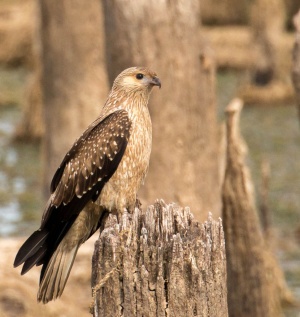(→External Links: Multiple GSearches combined) |
|||
| (13 intermediate revisions by 8 users not shown) | |||
| Line 1: | Line 1: | ||
| − | + | [[Image:5419whistling kite.JPG|thumb|500px|right|Photo © by {{user|joe+cockram|joe cockram}}<br />[[Kakadu National Park]], [[Australia]], July 2006]] | |
| − | [[Image: | + | ;[[:Category:Haliastur|Haliastur]] sphenurus |
==Identification== | ==Identification== | ||
| − | </ | + | [[Image:IMG 54921.jpg|thumb|300px|right|Juvenile<br />Photo © by {{user|Woom|Woom}}<br />Lake Mulwala, [[Victoria]], May 2015]] |
| − | < | + | 51–59 cm (20-23¼ in)<br /> |
| − | < | + | *Pale buff head, breast and tail |
| − | + | *Brown wings | |
| + | *Black flight feathers | ||
| + | *Bone-coloured legs and feet<br /> | ||
| + | '''Females''' are larger and heavier than males<br /> | ||
| + | '''Immature''' birds are a heavily-streaked rufous-brown with prominent pale wing spots | ||
| + | ==Distribution== | ||
| + | [[Australasia]]: Breeds in eastern [[New Guinea]], [[New Caledonia]] and widely distributed in [[Australia]] where it occurs virtually throughout the mainland. | ||
| − | < | + | Resident over most of range but nomadic in parts of Australia. |
| − | + | ||
| + | Vagrants recorded on [[Tasmania]] and King Island. | ||
| + | ==Taxonomy== | ||
| + | This is a [[Dictionary_M-S#M|monotypic]] species<sup>[[#References|[1]]]</sup>. | ||
| + | ==Habitat== | ||
| + | [[Image:Whistling Kite 1 of 1 .jpg|thumb|350px|right|Photo © by {{user|Ken+Doy|Ken Doy}}<br />Eagleby, [[Queensland]], [[Australia]], June 2018]] | ||
| + | Open woodland, grassland with scattered trees, lakesides, swamps and riverine woodland. | ||
| + | ==Behaviour== | ||
| + | ====Diet==== | ||
| + | The diet consists of small mammals (particularly rabbits), birds, fish, reptiles, amphibians, crustaceans, insects and carrion (especially important in the winter months). | ||
| + | ====Breeding==== | ||
| + | The bulky platform stick nest is placed in a tall tree. It is lined with green leaves. The clutch consists of 2–3 bluish-white eggs, (may be covered with reddish-brown blotches); incubation lasts for 35–40 days. The young fledge after 44–54 days. | ||
| + | ==References== | ||
| + | #{{Ref-Clements6thAug17}}#Handbook of the Birds of the World Alive (retrieved May 2017) | ||
| + | #Wikipedia | ||
| + | {{ref}} | ||
==External Links== | ==External Links== | ||
| − | + | {{GSearch|"Haliastur sphenurus" {{!}} "Whistling Kite"}} | |
| − | + | {{GS-checked}}1 | |
| − | [[Category: | + | <br /> |
| + | <br /> | ||
| + | |||
| + | [[Category:Birds]][[Category:Haliastur]] | ||
Latest revision as of 23:03, 14 September 2023
- Haliastur sphenurus
Identification
51–59 cm (20-23¼ in)
- Pale buff head, breast and tail
- Brown wings
- Black flight feathers
- Bone-coloured legs and feet
Females are larger and heavier than males
Immature birds are a heavily-streaked rufous-brown with prominent pale wing spots
Distribution
Australasia: Breeds in eastern New Guinea, New Caledonia and widely distributed in Australia where it occurs virtually throughout the mainland.
Resident over most of range but nomadic in parts of Australia.
Vagrants recorded on Tasmania and King Island.
Taxonomy
This is a monotypic species[1].
Habitat
Open woodland, grassland with scattered trees, lakesides, swamps and riverine woodland.
Behaviour
Diet
The diet consists of small mammals (particularly rabbits), birds, fish, reptiles, amphibians, crustaceans, insects and carrion (especially important in the winter months).
Breeding
The bulky platform stick nest is placed in a tall tree. It is lined with green leaves. The clutch consists of 2–3 bluish-white eggs, (may be covered with reddish-brown blotches); incubation lasts for 35–40 days. The young fledge after 44–54 days.
References
- Clements, J. F., T. S. Schulenberg, M. J. Iliff, D. Roberson, T. A. Fredericks, B. L. Sullivan, and C. L. Wood. 2017. The eBird/Clements checklist of birds of the world: v2017, with updates to August 2017. Downloaded from http://www.birds.cornell.edu/clementschecklist/download/
- Handbook of the Birds of the World Alive (retrieved May 2017)
- Wikipedia
Recommended Citation
- BirdForum Opus contributors. (2024) Whistling Kite. In: BirdForum, the forum for wild birds and birding. Retrieved 28 May 2024 from https://www.birdforum.net/opus/Whistling_Kite
External Links
GSearch checked for 2020 platform.1






